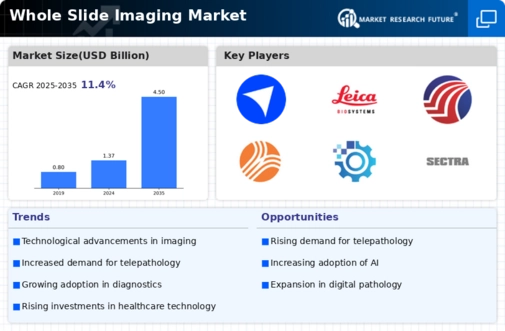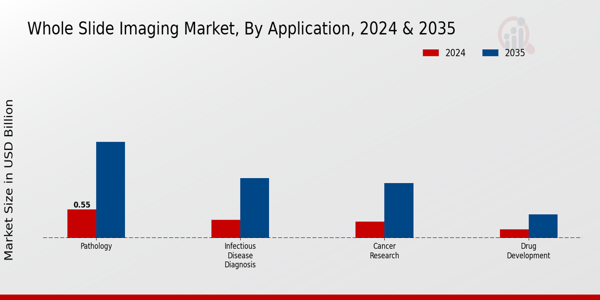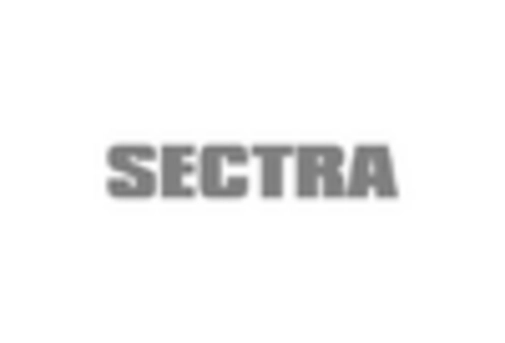Market Growth Projections
The Global Whole Slide Imaging Market Industry is projected to experience substantial growth over the next decade. With a market value of 1.37 USD Billion in 2024, it is expected to reach 4.5 USD Billion by 2035, indicating a robust compound annual growth rate of 11.42% from 2025 to 2035. This growth trajectory reflects the increasing adoption of whole slide imaging technologies across various healthcare settings, driven by factors such as technological advancements, rising chronic disease prevalence, and regulatory support. The market's expansion is likely to create new opportunities for stakeholders, including manufacturers, healthcare providers, and technology developers.
Technological Advancements
The Global Whole Slide Imaging Market Industry is experiencing rapid technological advancements that enhance imaging quality and efficiency. Innovations in digital pathology, such as high-resolution scanners and advanced image analysis software, are transforming traditional histopathology practices. For instance, the integration of artificial intelligence in image analysis allows for more accurate diagnoses and faster turnaround times. As a result, the market is projected to grow from 1.37 USD Billion in 2024 to 4.5 USD Billion by 2035, reflecting a compound annual growth rate of 11.42% from 2025 to 2035. This growth indicates a strong demand for improved diagnostic tools in healthcare settings globally.
Increasing Demand for Telepathology
The Global Whole Slide Imaging Market Industry is witnessing a surge in demand for telepathology solutions, driven by the need for remote diagnostics and consultations. Telepathology allows pathologists to share and analyze digital slides over the internet, facilitating collaboration across geographical boundaries. This trend is particularly beneficial in rural or underserved areas where access to specialized medical expertise is limited. The ability to conduct remote consultations not only enhances patient care but also optimizes resource utilization in healthcare facilities. As the demand for telepathology continues to rise, it is expected to significantly contribute to the market's growth in the coming years.
Rising Prevalence of Chronic Diseases
The Global Whole Slide Imaging Market Industry is significantly influenced by the rising prevalence of chronic diseases, which necessitates advanced diagnostic techniques. Conditions such as cancer, cardiovascular diseases, and diabetes require precise and timely diagnosis for effective management. Whole slide imaging provides pathologists with detailed visualizations of tissue samples, enabling them to identify abnormalities more accurately. As the global population ages and the incidence of chronic diseases increases, the demand for efficient diagnostic tools is likely to escalate. This trend is expected to drive the market forward, as healthcare providers seek to adopt technologies that improve diagnostic accuracy and patient outcomes.
Regulatory Support for Digital Pathology
The Global Whole Slide Imaging Market Industry benefits from increasing regulatory support for digital pathology solutions. Regulatory bodies are progressively recognizing the value of digital imaging technologies in enhancing diagnostic accuracy and efficiency. For example, several countries have established guidelines and frameworks to facilitate the adoption of whole slide imaging in clinical practice. This regulatory backing not only promotes the integration of digital pathology into healthcare systems but also instills confidence among healthcare providers regarding the reliability of these technologies. As regulations continue to evolve in favor of digital solutions, the market is poised for substantial growth.
Growing Investment in Healthcare Infrastructure
The Global Whole Slide Imaging Market Industry is bolstered by growing investments in healthcare infrastructure, particularly in developing regions. Governments and private entities are increasingly allocating funds to modernize healthcare facilities and adopt advanced diagnostic technologies. This investment trend is crucial for enhancing the capabilities of pathology departments, enabling them to implement whole slide imaging systems effectively. Improved healthcare infrastructure not only supports the integration of digital pathology but also enhances overall patient care. As investments continue to rise, the market is likely to experience accelerated growth, driven by the demand for state-of-the-art diagnostic solutions.





















Leave a Comment